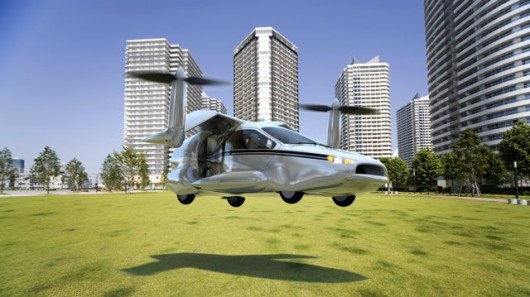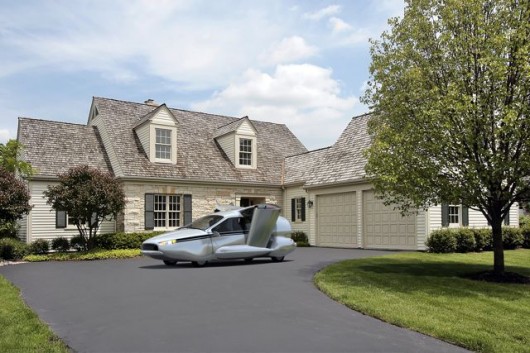Terrafugia announces its plans for a VTOL "flying car"
By Ben Coxworth
May 6, 2013

Terrafugia has announced its plans to develop a vertical-take-off-and-landing flying car, known as the TF-X (Image: Terrafugia)
Although countless small companies have tried to commercially develop flying cars over the past several decades, we’re still not seeing Blade Runner-esque vehicles cruising over our rooftops ... yet. Terrafugia is one of the groups currently trying to change that situation – a fully-functioning prototype of its Transition fixed-wing “roadable airplane” is currently undergoing flight tests, and was recently cleared for civilian use by the US Federal Aviation Authority. It still requires a runway for take-off and landing, though, which kind of clashes with many peoples’ flying car fantasies. Well, today Terrafugia announced its plans for a hybrid-drive vertical-take-off-and-landing (VTOL) vehicle, known as the TF-X.
Like the Transition, plans call for the 4-passenger TF-X to feature wings that fold into its sides, allowing it to fit on roads and in garages when in fully-electric ground mode. When it’s time to take off, however, those wings will extend into their flight position, and retractible propellers will open out of two 600-hp electric motor pods – one on each wing tip. Each pod will contain 16 separate motors, to keep everything in the air should one or more of them malfunction.
Initially, those props will be pointing upwards, allowing them to pull the TF-X up off the ground. Once the vehicle is sufficiently airborne, however, the propellers will rotate forward, allowing it to move ahead. Once the TF-X has gained enough forward momentum, the two wing-mounted propellers (but not the wings!) can once again be retracted, with a 300-hp internal combustion engine powering a single large rear-mounted ducted prop while cruising. The wing props will be re-engaged as the landing site approaches.
The engine will charge the batteries used by the electric motors, although they can also be charged simply by plugging into an electric vehicle charger when parked.
Before you start picturing yourself flying a TF-X off of your driveway, however, Terrafugia does state that the vehicle will require a clearing at least 100 feet (30.5 meters) in diameter for takeoff. This means that users will most likely drive their vehicle to and from designated landing sites similar to those used by helicopters, and fly between those sites.
That said, unlike the case with a helicopter, the designers believe that it should only take about five hours to learn how to fly the TF-X. This is largely because users will have the option of flying it in automatic mode, in which they just input the location of their destination landing site (along with some back-up secondary choices), then leave the navigation to the vehicle.
It will subsequently travel at a cruising speed of 200 mph (322 km/h), going up to 500 miles (805 km) without needing to refuel or recharge. While cruising in automatic mode, it will be able to automatically avoid other air traffic, along with inclement weather, restricted airspace and tower-controlled airspace (which pilots would require additional training to fly in). It will also automatically land itself at the destination (if weather allows), although the pilot will be able to override that function if they notice any hazards at the chosen landing site.
Should the TF-X just crap out completely in mid-air, the pilot can activate a parachute system to keep it from crashing to the ground. Likewise, if the onboard control system detects that the vehicle is being piloted in an unsafe manner, it will automatically declare an emergency and contact the relevant authorities. Should the pilot be unresponsive to prompts by the system, it will automatically land the vehicle at the closest airport.
All of this is still at least 8 to 12 years away, though, as that’s how long Terrafugia figures it will take to develop a commercially viable product. The only estimate on price is that it could be “on-par with very high-end luxury cars of today.”
Animation of the TF-X in flight can be seen in the video below.
Source: Terrafugia
Copyright © gizmag 2003 - 2013 To subscribe or visit go to: http://www.gizmag.com
http://www.gizmag.com/terrafugia-vtol-tf-x-flying-car/27402

